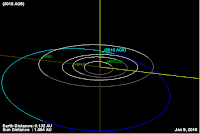Asteroid
(438661) 2008 EP6 passed by the Earth at a distance of 7 505 000 km
(19.5 times the average distance between the Earth and the Moon, or 5.02% of the average distance between the Earth and the Sun), at about 2.20 am GMT on Wednesday 27 January 2016. There was no danger of
the asteroid hitting us, though had it done so it would have presented a
considerable threat. (438661) 2008 EP6 has an estimated equivalent
diameter of 250-780 m (i.e. a spherical body with the same mass would be 250-780 m in diameter), and an object of this size
would pass through the atmosphere and directly impact the ground with a
force of about 600-20 000 megatons (about 35 000-1 175 000 times the explosive energy of
the Hiroshima bomb), causing devastation over a wide area and creating a
crater 4-12 km across, and resulting in global climatic problems that
could last for decades or even centuries.
(438661) 2008 EP6 was first observed by Siding Spring Observatory in
New South Wales on 5 March 2008. The designation 2008 EP6 indicates
that it was the 165th asteroid (asteroid P6) discovered in the first
half of March 2008 (period 2008 E). The
longer designation, (438661), indicates that the asteroid was the 438 661st asteroid ever discovered. Asteroids are not given this longer
designation immediately, to avoid duplicate or false sightings.
(438661) 2008 EP6 has a 486 day orbital period and an eccentric orbit tilted at an
angle of 17.7° to the plane of the Solar System, which takes it from
0.85 AU from the Sun (i.e. 85% of the average distance at which the
Earth orbits the Sun) to 1.56 AU from the Sun (i.e. 156% of the average
distance at which the Earth orbits the Sun, slightly outside the
orbit of Mars). It is therefore classed as an Apollo Group Asteroid (an
asteroid that is on average further from the Sun than the Earth, but
which does get closer). This means that close encounters between the
asteroid and Earth are extremely common, with the last having occurred
in August 2015 and the next predicted in August 2019. As an asteroid
probably larger than 150 m in diameter with an orbit that brings it to within
0.05 AU (750 000 km) of the Earth, (438661) 2008 EP6 is also classified as a Potentially
Hazardous Asteroid.
See also...
 Asteroid 2016 AH164 passes the Earth. Asteroid
2016 AH164 passed by the Earth at a distance of 26 660 km (0.08 times
the average distance between the Earth and the Moon, or 0.02% of
the average distance between the Earth and the Sun; 6660 km above the
orbit at which the satellites supporting...
Asteroid 2016 AH164 passes the Earth. Asteroid
2016 AH164 passed by the Earth at a distance of 26 660 km (0.08 times
the average distance between the Earth and the Moon, or 0.02% of
the average distance between the Earth and the Sun; 6660 km above the
orbit at which the satellites supporting... Asteroid 2016 AO8 passes the Earth. Asteroid
2016 AO8 passed by the Earth at a distance of 18 950 000 km (49.4 times
the average distance between the Earth and the Moon, or 12.7% of the
average distance between the Earth and the Sun), slightly before 0.55 am
GMT on Saturday 2...
Asteroid 2016 AO8 passes the Earth. Asteroid
2016 AO8 passed by the Earth at a distance of 18 950 000 km (49.4 times
the average distance between the Earth and the Moon, or 12.7% of the
average distance between the Earth and the Sun), slightly before 0.55 am
GMT on Saturday 2... Asteroid 2015 XC352 passes the Earth. Asteroid
2015 XC352 passed by the Earth at a distance of 1 991 000 km (5.18 times
the average distance between the Earth and the Moon, or 1.33% of
the average distance between the Earth and the Sun),
slightly after 7.00 pm GMT on Wednesday...
Asteroid 2015 XC352 passes the Earth. Asteroid
2015 XC352 passed by the Earth at a distance of 1 991 000 km (5.18 times
the average distance between the Earth and the Moon, or 1.33% of
the average distance between the Earth and the Sun),
slightly after 7.00 pm GMT on Wednesday...
Follow Sciency Thoughts on Facebook.

